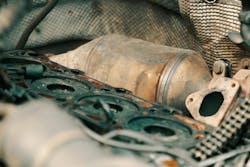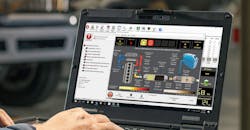Understanding DPF failure modes and how to diagnose emissions systems
Diesel particulate filters (DPFs) do the heavy lifting in diesel emissions systems by catching contaminants from the engine exhaust in their ceramic honeycomb interior. And diesel-powered commercial vehicles—from half-ton pickups and box trucks to city transit buses and semis—require efficient DPFs to lower their emissions and adhere to Federal Highway Administration guidelines. It's a dirty job, and the DPFs go through regular regeneration cycles where heat is used to burn all that soot up to promote air flow and avoid clogs.
Because this doesn't always go smoothly, and even when it does emissions and particluate matter do still enter the atmosphere, experts are working to advance filter engineering and general efficiency, while also easing maintenance. To keep up with innovations and enhance uptime, it is vital for diesel technicians to know what causes DPF failures, how to spot problems, and how to fix them.
Common DPF failures and causes
DPF failure occurs when soot and other particulates clog your vehicle’s filter. This is usually because the system did not generate enough heat to burn the soot, requiring the driver to pull over and perform a forced regeneration. That can take the vehicle out of commission for 40 minutes to an hour.
Several factors can contribute to an overloaded DPF:
- Extended idle times: A DPF cannot effectively burn off collected particulates while the engine is idling, so a diesel engine is more likely to experience DPF problems the longer it idles.
- Trucks running short routes: The frequent stopping and starting that occurs when trucks travel short distances does not allow the DPF to reach the temperature necessary to burn off soot.
- Exhaust gas recirculation (EGR) valve issues: The EGR valve recirculates the carbon deposits that accumulate in the exhaust gas. A malfunctioning EGR valve can lead to carbon buildup, clogging the DPF.
- Turbo failure: A failed turbocharger decreases the engine’s power and can lead to too much pressure in the exhaust system, clogging the DPF.
- Fuel quality: Dirty or mixed fuel can lead to DPF blockages and damage.
- Faulty fuel injectors: Faulty fuel injectors often cause fuel inefficiency, overheating and incomplete combustion. These issues result in increased soot production, which overloads the DPF.
How to diagnose a faulty DPF
To catch and mitigate issues as early as possible, watch out for these five warning signs of a faulty DPF:
- Your vehicle is emitting black smoke from its exhaust pipe.
- Your DPF warning light is on.
- Your vehicle is using more fuel than it should.
- Your vehicle feels less responsive and generally weaker.
- Your engine will not start.
Preventively cleaning your DPF decreases the likelihood of failure and clogging. You can use high-pressure, compressed air or a chemical cleaning solution.
There are two types of chemical cleaning solutions—fuel additives and spray-on systems. You can typically use fuel additives without having to take out the DPF. Spray-on systems work well if you have removed your vehicle’s filter for cleaning and want even better results after using compressed air.
DPF repair techniques
Regeneration is your DPF’s self-cleaning process. It involves burning off collected soot and particulates trapped in the engine’s exhaust gases, which is key to keeping your DPF clean and only occurs when the filter reaches about 1,112 degrees F. DPF clogging can prevent the filter from reaching the right temperature. At this point, either the driver or a mechanic must activate the regeneration process.
The most common method of repairing your DPF yourself is passive regeneration. Passive regeneration requires driving at a constant high speed to burn off your DPF’s collected soot naturally. It is simple and cost-effective since it requires no additional fuel or tools, but since it requires consistently high speed, you cannot do it in stop-and-go traffic or on many urban roads.
If you experience consistent DPF blockages, a technician may opt for active regeneration, which involves injecting fuel into the exhaust stream to increase the temperature, thereby burning off accumulated soot. Active regeneration does not depend on the driving environment like passive regeneration but does require additional fuel.
Finally, a technician may try forced regeneration if neither passive nor active regeneration works. They typically use forced regeneration when a DPF is severely clogged, which requires a specialized diagnostic tool to remove soot buildup.
Advances in DPF diagnosis and repair
As engine emissions regulations become stricter to decrease diesel pollution, global demands for cleaner diesel engines increase. Experts in the automotive industry are working to improve the efficiency of DPFs and repair techniques.
New filter materials like aluminum titanate (AT) are replacing traditional materials like silicone carbide and cordierite. AT is a cost-effective material with a heat capacity of 3,380 degrees F (1,860 degrees C) and strong chemical resistance. Diagnostic scan tools can also now provide insight into soot load, differential pressure, and ash accumulation levels.
Effective DPF maintenance
Regularly cleaning your DPF is essential for your vehicle’s effective and environmentally safe operation. If you regularly experience fuel inefficiency, a nonresponsive engine, a weaker vehicle, or black smoke emission from your exhaust pipe, it may be DPF failure. Regenerate your filter or seek guidance from a skilled technician.
About the Author

Jack Shaw
Jack Shaw is a seasoned writer and editor with a robust background in the automotive manufacturing and engineering sectors. Currently serving as the automotive editor of Modded, he focus on researching and writing articles that delve into the latest trends and technologies shaping the industry. His insights featured in EPS News, Manufacturing Engineering Magazine, Car Mechanics Magazine and more.

